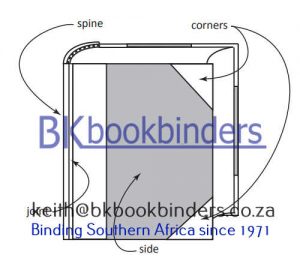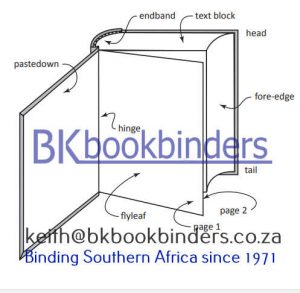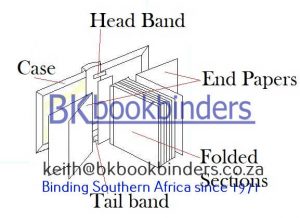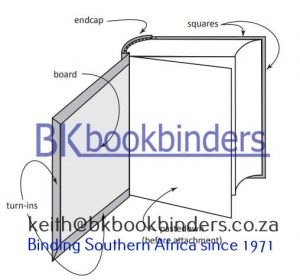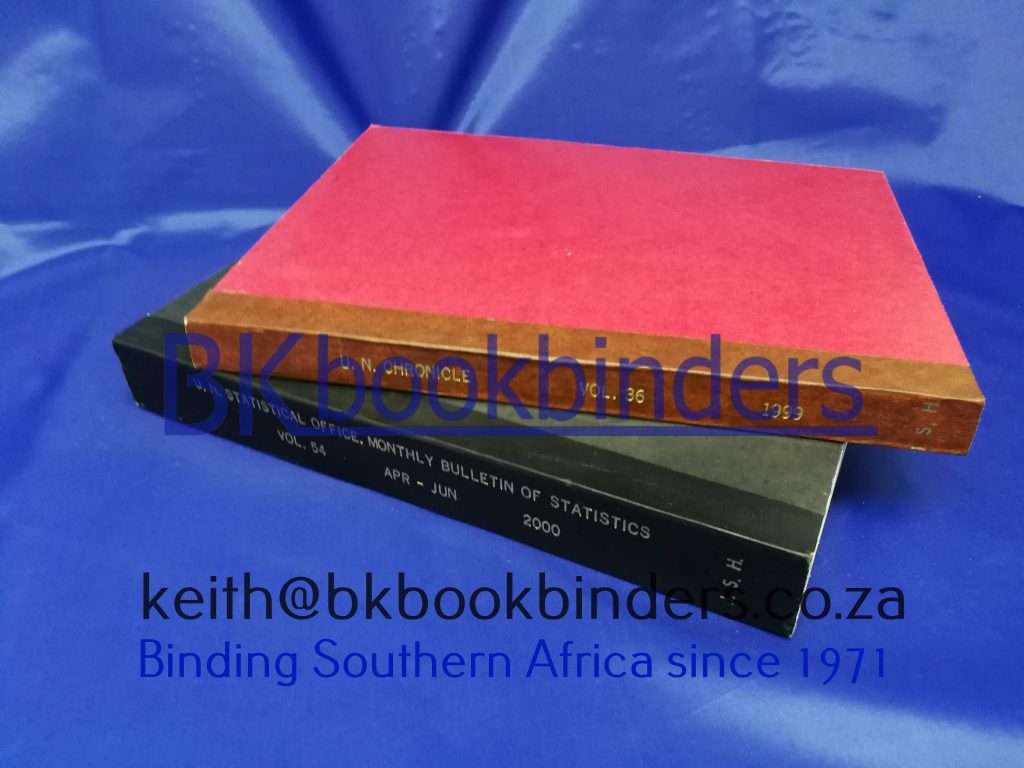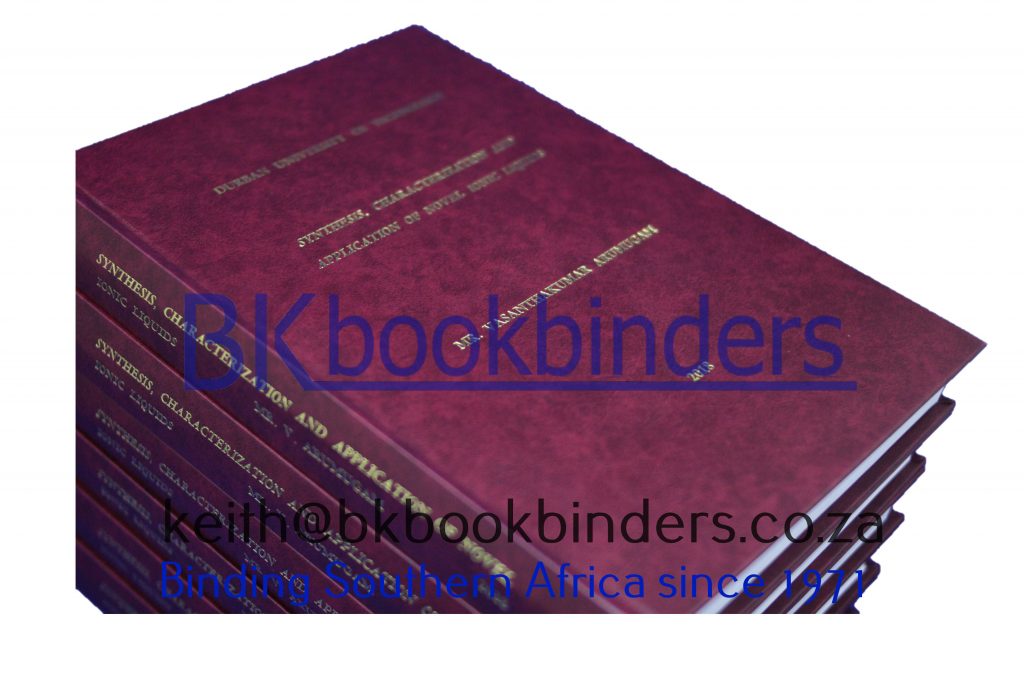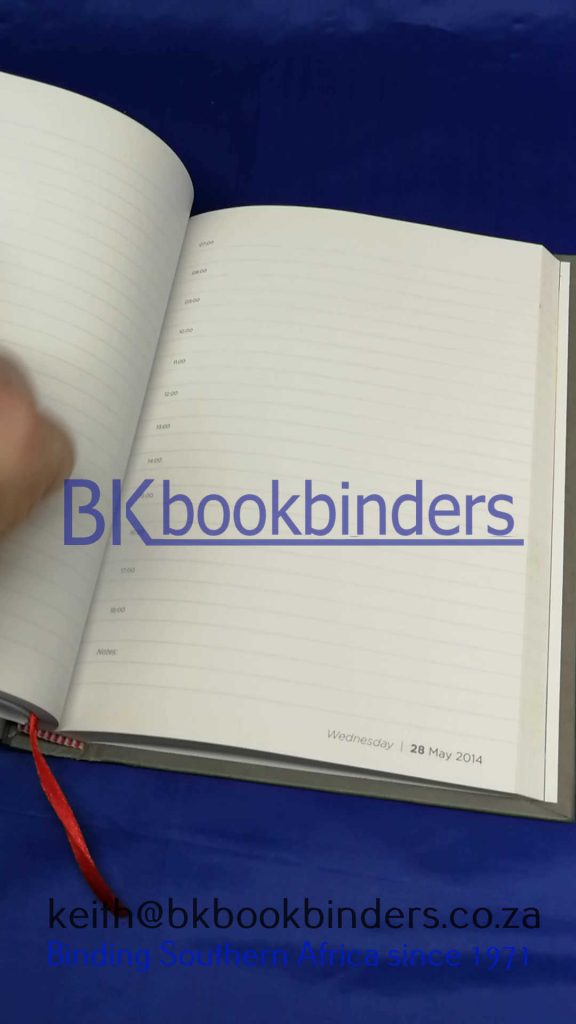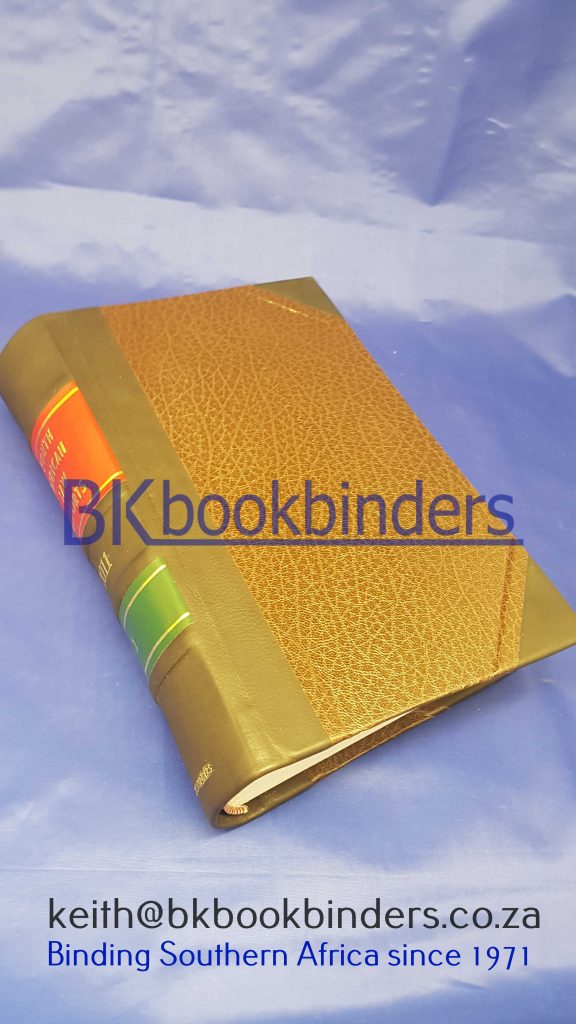Some common Bookbinding TERMS & DEFINITIONS
Board
Cardboard or thin wood cover cores around which buckram or leather is wrapped to make a case (cover) for a book.
Book block (also called a text block)
Pages of a book that have been sewn or glued together into a single unit, then trimmed around three edges to remove signature folds, but not yet cased into a cover.
Buckram
Traditional usage: A coarse fabric saturated with stiff sizing that is used for binding books and adding strength and stiffness to leather goods.
Common usage: Any non-leather fabric manufactured specifically for binding books. Modern buckrams are usually attractively colored and textured plastic attached to a strong fabric under-layer for strength. From old French boquerant, linen.
Case
An assembly consisting of front and back covers attached to the spine. The operation of attaching the covers of a book to the book block is called “casing in.”
Copyright
(as a bookbinding term) A page after the title page that contains legal and printing information.
Cover
An outer surface nearly the size of the pages and attached to the spine by a hinge mechanism. Front and back covers are usually the same material as the spine, forming a one piece protective “case” around the book. Many years ago, covers were carved from wood and attached to the spine with cloth or metal hinges. Modern covers are made of many materials–paper, plastic, or fabric–though most are a cardboard core covered with paper, leather, or book cloth (buckram).
Dust jacket
A paper “wrapper” around a bound book intended to attract a purchaser through illustrations, descriptions, or other information. Dust jackets are not intended to last as long as the bound volume, but many collectors prefer books with the original dust jacket intact.
Edition
All of the copies of a book manufactured by a single printing and binding run. “First Edition” always designates the original publication, and are more popular with collectors.
End sheet
A piece of stiff paper folded once in half and attached to the inside of the covers and to the spine of the book block. End sheets are usually plain, white stock, but can be more ornate in Holy Bibles and high-quality books. Their purpose is mainly for appearance, to conceal the edges of buckram or leather attached to the cover core, and conceal the thread and glue on the spine edge of the book block. Heavier weight end sheets also contribute to the strength of the binding and extend the life of the book.
Fore-Edge (Face)
The edge of book pages opposite the spine. This is the edge that is normally grasped when turning the pages.
Folio
Traditional usage: A sheet of paper folded once in the middle, making four pages of a book. Also may be called a signature.
Common usage: A numbered page of a book or the actual number printed on the page. “Low folio” refers to the half of the folio in the front part of the book, or the half of the folio with the lowest numbers. “High folio” refers to the half of the folio in the back part of the book, or the half of the folio with the highest numbers.
Occasionally used to describe a large book, 15 or more inches high, made with folded pages. From Latin folio, a leaf.
Foot
The bottom page edges or the bottom of the spine.
Frontpiece
A page prior to the title page containing an illustration.
Gilt
Gold edging on pages of bibles and other books. Originally applied as a dust and rubbed into the paper fibers, gilt is now applied to the edges of book blocks with heat and adhesive. Similar decorations included red and green edging, done with ink, and marble edging, an obscure method of swirling several ink colors on top of a vat of hot liquid and carefully touching the book block edges to the mixture.
Half-bound
Hard bound books covered in paper or buckram, then reinforced with leather down the spine and on the corners. Most typical of courthouse record books.
Head
The top page edges or the top of the spine.
Headband
A fabric band, often decoratively colored, that is attached to the head and foot of the spine. Headbands add strength to these points of stress and also conceal any glue and thread that might have been visible after binding.
Hinge
The thin areas of the case that fold back allowing the book to be opened and closed.
Oversewing
Sewing sections or groups of pages rather than sewing through all pages at one time to allow more flexibility in the spine
Page
One side of a sheet of paper. Sheets x 2 = # pages in a book.
Perfect binding (also called adhesive binding)
A pamphlet binding process using only adhesive, usually a hot-melt, to secure the pages into a wrap-around cover. Telephone books and paperbacks are typical of Perfect binding.
Quarter-bound
Hard bound books cased in paper or buckram, then reinforced with leather down the spine and extending a couple of inches onto the covers.
Raised-Bands (Hubs)
Raised bands on the spine made with built-up layers -usually found on highly decorative bound books.
Rounding
A process that gives curvature to a book’s spine
Section sewn (also called Smythe sewing)
Thread is sewn through the folded centers of each section of pages. Section sewn books open easily and lie a bit flatter than side sewn books.
Side sewnThread is sewn through all of a book’s pages about 1/8 inch from the binding edge of the pages. Side sewing is very secure, but books sewn in this fashion seldom lie flat when open.
Signature (often abbreviated sig and also called a section)
A sheet of paper printed with four or more pages and folded one or more times to the approximate size of one page and in a manner which puts the pages in proper numbered order. The more common signature impositions are 4, 8, 16, 32, and 64 pages, which are formed by folding the sheet in half one or more times. Less common are 12, 20, 24, and 36 page signatures, which require more complicated folding patterns.
In some regions, signatures are identified by their lowest page number, so the second signature in a two section, 16 page book might be called “sig 5,” because it begins with page 5. In recent years, and in most regions, signatures are identified by their position in the book, so the example might also be called “sig 2.” The cover of the book is not considered a signature in any numbering scheme. From Latin signum, sign.
a rounded and backed book spine
The bound edge of a book where the pages are sewn, glued, or otherwise fastened together. Spines are usually thin and flexible, allowing the book to be easily opened. Highly decorated books have spines that have been “built up” into hubs and ornamentation. Also see rounding and backing.
Find out more terms and definitions at AHLS or at Abe Books. We are not associated with ether company but share their online passion for books and book awarenes

